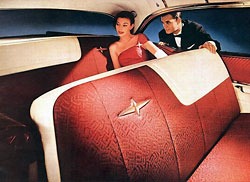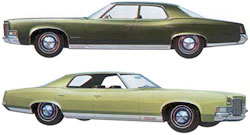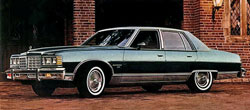1959-1976 Bonneville
 Pontiac wasn’t mincing words when it dubbed a more stylish, performance-oriented special model Bonneville in 1957. The name was synonymous with speed, as record-breaking exploits from the expansive salt flats in Utah regularly made headlines – and the company was working hard to change perceptions about a lineup viewed as anything but racy.
Pontiac wasn’t mincing words when it dubbed a more stylish, performance-oriented special model Bonneville in 1957. The name was synonymous with speed, as record-breaking exploits from the expansive salt flats in Utah regularly made headlines – and the company was working hard to change perceptions about a lineup viewed as anything but racy.
Only 630 Bonnevilles were built the first year – roughly one per dealership – but the powerful, mechanical fuel-injected V-8 engine that powered them, along with some key motorsports successes, did the trick and the public’s opinion of Pontiac began a seismic shift. The Bonneville would become the brand’s flagship, rolling through 10 generations and lasting nearly 50 years in the market.
 The 1959 Bonneville was a landmark car for Pontiac. It assumed the top position in the lineup, added hardtop sedan and wagon models and was the flag bearer for the all-new Wide Track campaign. More than a styling cue or advertising ploy, it was an architectural distinction that pushed the wheels farther out to enhance handling. It was a performance trait customers could feel and they liked the sportier, more secure driving experience. Pontiac had registered another significant advance in its war against stodginess.
The 1959 Bonneville was a landmark car for Pontiac. It assumed the top position in the lineup, added hardtop sedan and wagon models and was the flag bearer for the all-new Wide Track campaign. More than a styling cue or advertising ploy, it was an architectural distinction that pushed the wheels farther out to enhance handling. It was a performance trait customers could feel and they liked the sportier, more secure driving experience. Pontiac had registered another significant advance in its war against stodginess.
The ’59 Bonneville – and the entire Pontiac lineup – also introduced the split-grille design cue that would become a fundamental element of the brand’s styling. In the Sixties, the Bonneville continued as Pontiac’s most luxurious model line, with upholstery and trim not available on other models. Performance was strong, too, from a range of 389 and 421 V-8s, and later 400 and 428 engines, although with a platform that stretched 124 inches in wheelbase and 220 inches in overall body length, performance was a relative term for these long, low highway cruisers. For comparison, the 1960 Bonneville had an 8-inch-longer wheelbase than a modern Chevrolet Tahoe SUV – and the body was 18 inches longer!
Redesigned and Repositioned
 In 1971 the Bonneville was redesigned with other vehicles on GM’s full-size B-body platform. It retained a lengthy 123.4-inch wheelbase and grew to more than 225 inches in overall length. Its position atop Pontiac’s roster changed and it slid in under the Grand Ville model, but that would prove to be a relatively brief lineup shuffle.
In 1971 the Bonneville was redesigned with other vehicles on GM’s full-size B-body platform. It retained a lengthy 123.4-inch wheelbase and grew to more than 225 inches in overall length. Its position atop Pontiac’s roster changed and it slid in under the Grand Ville model, but that would prove to be a relatively brief lineup shuffle.
Like all cars of the Seventies, falling horsepower levels and rising federal regulations saddled the Bonneville with more mass and less grunt to push it around. As customers turned to smaller, more fuel-efficient cars, holdover dinosaurs like the Bonneville and other full-size competitors faced downward pressure on dealer lots. The Bonneville again took the top spot in Pontiac’s lineup in 1976, but era of Detroit’s luxo-land yachts was coming to an end.
 In 1977 an all-new, smaller, lighter and more efficient Bonneville was introduced, reflecting a radical upheaval in the industry, and in 1987 the car was moved to a front-drive platform – a configuration that drove the car through the end of its production in 2005. And while the front-drive Bonneville enjoyed nearly 20 years of success, it was the original era of the chrome-decked, luxuriously appointed models forged its reputation.
In 1977 an all-new, smaller, lighter and more efficient Bonneville was introduced, reflecting a radical upheaval in the industry, and in 1987 the car was moved to a front-drive platform – a configuration that drove the car through the end of its production in 2005. And while the front-drive Bonneville enjoyed nearly 20 years of success, it was the original era of the chrome-decked, luxuriously appointed models forged its reputation.
They didn’t make them any larger than the classic Bonneville. It was a car for long drives with the windows down and an arm slung over the wide, Morrokide-trimmed front seat. It was truly an American original.
Original Parts Group offers thousands of 1959-76 Bonneville parts and accessories, with new parts added daily. Our extensive catalog offers nearly everything from sheet metal, chrome and upholstery to engine parts and the hard-to-find details to finish a restoration with show-winning attention to detail. Our prices make that restoration more affordable, too! Shop online or order your OPGI 1959-76 Bonneville parts catalog today!